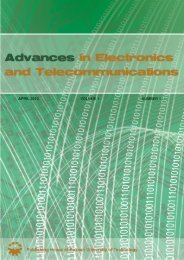november 2010 volume 1 number 2 - Advances in Electronics and ...
november 2010 volume 1 number 2 - Advances in Electronics and ...
november 2010 volume 1 number 2 - Advances in Electronics and ...
You also want an ePaper? Increase the reach of your titles
YUMPU automatically turns print PDFs into web optimized ePapers that Google loves.
ADVANCES IN ELECTRONICS AND TELECOMMUNICATIONS, VOL. 1, NO. 2, NOVEMBER <strong>2010</strong> 63<br />
Are Carrier Transport Effects Important for Chirp<br />
Model<strong>in</strong>g of Quantum-Well Lasers?<br />
Abstract—The paper <strong>in</strong>vestigates the impact of carrier transport<br />
effects on the chirp model<strong>in</strong>g of quantum-well lasers.<br />
Particularly, the difference between the full model<strong>in</strong>g based on<br />
quantum-well laser rate equations is compared with model<strong>in</strong>g<br />
based on formulas derived for bulk lasers. As it was shown,<br />
the relations between chirp <strong>and</strong> <strong>in</strong>tensity modulation are quite<br />
similar <strong>in</strong> both cases.<br />
Index Terms—laser chirp, laser model<strong>in</strong>g<br />
Przemysław Krehlik<br />
I. INTRODUCTION<br />
THE quantum-, or multi-quantum-well (QW, or MQW)<br />
structure <strong>in</strong>troduced to the semiconductor laser design<br />
implies some new phenomena <strong>in</strong> the device operation, when<br />
compared with the bulk laser design. Among them the<br />
transport of <strong>in</strong>jected carriers across the separate-conf<strong>in</strong>ementheterostructure(SCH)<strong>and</strong>captur<strong>in</strong>gthem<strong>in</strong>totheQWregions<br />
<strong>in</strong>troduce some delay <strong>in</strong> the carriers flow. Consequently, noticeable<br />
variationsof theconcentrationof carriersaccumulated<br />
<strong>in</strong> SCH region occur. Because a large fraction of the optical<br />
mode lies <strong>in</strong> the SCH, this carrier density variations affect the<br />
las<strong>in</strong>g frequency i.e. <strong>in</strong>troduces a new chirp component.<br />
There are plenty of papers <strong>in</strong> which significant differences<br />
<strong>in</strong> chirp characteristics of bulk <strong>and</strong> QW lasers are po<strong>in</strong>ted out<br />
[1]–[4].On the other h<strong>and</strong>, there are some papers <strong>in</strong> which the<br />
QW laser chirp is modeled us<strong>in</strong>g equations derived for bulk<br />
device. In some of them the considerations are verified by<br />
experiments, which seems to proof such chirp treatment [5]–<br />
[7]. The aim of the work presented here<strong>in</strong> is to clarify this<br />
confus<strong>in</strong>g <strong>in</strong>consistency <strong>and</strong> to po<strong>in</strong>t out the area <strong>in</strong> which the<br />
simple chirp model may be used for QW lasers.<br />
II. THEORETICAL BASICS<br />
The basic mathematical model of semiconductorlaser is the<br />
set of rate equations, which describes the dynamics of carrier<br />
<strong>and</strong> photon densities, <strong>and</strong> relate them to the laser frequency<br />
chirp <strong>and</strong> the output optical power.<br />
A. Bulk laser model<strong>in</strong>g<br />
For the bulk laser the rate equations may be written <strong>in</strong> the<br />
follow<strong>in</strong>g form:<br />
dN<br />
dt<br />
I<br />
= −<br />
eVa<br />
N<br />
τe<br />
dS<br />
dt = Γg0(N − NT )<br />
S −<br />
1 + εgS<br />
S<br />
− g0(N − NT )<br />
S (1)<br />
1 + εgS<br />
τP<br />
+ ΓβN<br />
τe<br />
P. Krehlik is with the Institute of <strong>Electronics</strong>, AGH University of Science<br />
<strong>and</strong> Technology, Mickiewicza 30, 30-059 Kraków, Pol<strong>and</strong>; e-mail:<br />
krehlik@agh.edu.pl.<br />
(2)<br />
∆ν = α<br />
4π Γg0(N − NT H) (3)<br />
P = ηVahν0<br />
S (4)<br />
Γτp<br />
where N is the carrier concentration <strong>in</strong> the active region,<br />
S is the photon concentration, I is the <strong>in</strong>jected current, e<br />
is the electron charge, Va is the active region <strong>volume</strong>, τe<br />
is the carrier lifetime, g0 is the differential ga<strong>in</strong>, εg is the<br />
ga<strong>in</strong> compression factor, NT is the carrier concentration for<br />
transparency, NT H is threshold carrier concentration, Γ is<br />
the conf<strong>in</strong>ement factor, τp is the photon lifetime, β is the<br />
spontaneous emission coefficient, ∆ν is the optical frequency<br />
deviation(i.e.the chirp), α isthe l<strong>in</strong>eenhancementfactor, P is<br />
the output power, h is Planc’s constant, <strong>and</strong> ν0 is the nom<strong>in</strong>al<br />
optical frequency.<br />
As may be noticed, the frequency chirp is described by (3),<br />
which shows that the frequency deviation is proportional to<br />
the concentration of carriers <strong>in</strong> the laser active region.<br />
A serious practical drawback of the (3) is that it relates the<br />
chirp to the unobservable carrier concentration, which cannot<br />
be predicted without the precise knowledge about all the rate<br />
equationsparameters. Thus, it is very useful to relate the chirp<br />
to the measurable laser output power. Calculat<strong>in</strong>g the carrier<br />
concentration N from (2) <strong>and</strong> putt<strong>in</strong>g it <strong>in</strong>to (3), the frequency<br />
chirp may be related to the photon concentration. Ignor<strong>in</strong>g<br />
some negligible terms <strong>and</strong> us<strong>in</strong>g (4), we may f<strong>in</strong>ally relate the<br />
chirp to the laser output power:<br />
∆ν(t) = α<br />
4π<br />
�<br />
1 dP (t)<br />
+ κP (t)<br />
P (t) dt<br />
where κ = Γεg/(ηVahν0) is the so called adiabatic chirp<br />
coefficient. The part of the chirp <strong>in</strong>duced by the time derivate<br />
of power is called the dynamic chirp, <strong>and</strong> the part directly<br />
proportional to the power is called the adiabatic one.<br />
In case of small signal laser modulation, the frequency<br />
modulation (FM) efficiency may be determ<strong>in</strong>ed us<strong>in</strong>g (5). In<br />
the frequency doma<strong>in</strong> it takes the form:<br />
� �<br />
δν(ωm) α jωm δP (ωm)<br />
= + κ (6)<br />
δI(ωm) 4π 〈P 〉 δI(ωm)<br />
where δ(·) denotes the small signal component of each quantity,<br />
ωm is the angular frequency of laser modulation, 〈P 〉<br />
isthemeanopticalpower,<strong>and</strong> δP (ωm)/δI(ωm)isthe<strong>in</strong>tensity<br />
modulation (IM) efficiency.<br />
Thus, hav<strong>in</strong>g the knowledge about the laser IM behavior<br />
(some k<strong>in</strong>d of model or measured data) we need only two<br />
parameters (α <strong>and</strong> κ) to accurate chirp characterization. Some<br />
relatively simple measurement methods for determ<strong>in</strong><strong>in</strong>g these<br />
parameters are described <strong>in</strong> many papers [8].<br />
�<br />
(5)







